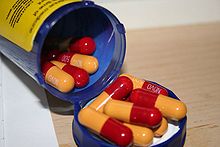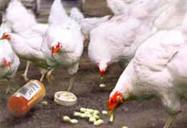 Are Antibiotics really the ‘Bad Guys’ that they now seem to be? Well, the answer may surprise you.
Are Antibiotics really the ‘Bad Guys’ that they now seem to be? Well, the answer may surprise you.
There are many different kinds of antibiotics. There are antibacterials, antivirals, antifungals, and antiparasitics. Each fight different types of (potentially) harmful organisms. The word antibiotics actually means “against life”. Which makes sense, because the life thing it is against is, in these cases, are living microbes.
A case for antibiotics:
“Even though the body’s disease-fighting immune system can often successfully fight off bacterial infections, sometimes the germs (microbes) are too strong and your child can get sick. For example,
- Before antibiotics, 90% of children with bacterial meningitis died. Among those children who lived, most had severe and lasting disabilities, from deafness to mental retardation.
- Strep throat was at times a fatal disease, and ear infections sometimes spread from the ear to the brain, causing severe problems.
- Other serious infections, from tuberculosis to pneumonia to whooping cough, were caused by aggressive bacteria that reproduced with extraordinary speed and led to serious illness and sometimes death.” According to – http://www.healthychildren.org/
[wpgfxm_contentbox width=”50%” bg_color=”#F1F8FB” b_color=”#D94A2E” style=”double” top=”1px” right=”none” bottom=”1px” left=”none” radius=”0px”]FREE Digital Subscription to PREPARE Magazine[/wpgfxm_contentbox]
A case against antibiotics:
In our recent history, antibiotics were prescribed far too frequently. Now, many physicians will wait for symptoms to improve or worsen on their own before prescribing an antibiotic. Why? Because the microbes adapt. When offered antibiotics frequently they ‘learn the code’, so to speak, and become resistant. When dosing improperly such as taking someone else’s prescription or not finishing a full prescription in it’s entirety, the microbes also adapt and resist the next attempt to use an antibiotic.
Another case against antibiotics is their use in animals we consume as food. This injection of antibiotics, though indirect, still has the same effect on the microbes that attack our body’s system. Meat or dairy raised with antibiotics – pass those antibiotics on to us when consumed.
A case for new antibiotics:
Once thought of as miracle drugs, antibiotics now are a treatment to be handled with more precision and care than previously thought. Gone is thought process that there is a blanket cure of “one drug kills all. We’re just not doing that anymore. Or are we? Below is a short article written by Dr. Joe Alton (aka: Dr. Bones) that introduces us to a new antibiotic that is not yet released.
[wpgfxm_contentbox width=”50%” bg_color=”#F1F8FB” b_color=”#D94A2E” style=”double” top=”1px” right=”none” bottom=”1px” left=”none” radius=”0px”]FREE Digital Subscription to PREPARE Magazine[/wpgfxm_contentbox]
Teixobactin, A New Antibiotic
by Joe Alton, M.D. of www.doomandbloom.net
There is an epidemic that I’ve mentioned in past articles, and it has spread to every continent: the epidemic of antibiotic resistance. Overuse of antibiotics in both humans and livestock (80% of antibiotics go to animals we eat) has resulted in drug-resistant strains of various microbes, including tuberculosis and salmonella.
In the last few years, no new antibiotics have come down the pipeline. Some current drugs are in their fourth generation, as pharmaceutical companies tweak existing medicines to gain time before the next resistant bug appears. This standstill bodes badly for a world that’s accustomed to technology moving at a faster pace every year. The era of totally drug resistant diseases may be dawning: A variant of tuberculosis in India that defies every method of treatment already exists.
A rare bit of good news, however, on the antibiotic front is the discovery of the first truly new antibiotic in decades: Teixobactin. It wasn’t born in a laboratory; it was found in the dirt beneath your feet. Researchers have suspected that the soil’s bacteria might have much to teach us regarding how to fight disease. Different species of bacteria battle each other every day. Most bacteria, however, don’t grow well in laboratories.Now, the journal “Nature” reports that scientists have figured out how to grow previously un-culturable bacteria using an electronic “isolation chip”. They report that they have isolated a new antibiotic, Teixobactin, which they claim has no detectable resistance issues. It apparently works well against organisms that have become hardened to standard antibiotics, like Staph. Aureus and Tuberculosis.
There are millions of unc
ultured bacteria in the soil that are yet to be grown and investigated. This new method of isolating these bacteria may lead to a number of new antibiotics. As well, other medicines for treatment against cancer, inflammation, and immune issues may one day be developed; it’s been described as the “tip of the ice berg”.
Teixobactin and other drugs are still in the FDA pipeline, so it’ll be a while before you’ll be given a prescription for it. Serious side effects have to be ruled out before it goes to the general public. Let’s hope that this new method will lead to more breakthroughs.
by Joe Alton, M.D. of www.doomandbloom.net
No matter what the future holds or the past may have taught us, it’s clear to see that how we use or misuse antibiotics plays the bigger roll in their effectiveness for our health. Be sure to treat yourself, your medications and your loved ones in need of medical attention with respect.
[wpgfxm_contentbox width=”50%” bg_color=”#F1F8FB” b_color=”#D94A2E” style=”double” top=”1px” right=”none” bottom=”1px” left=”none” radius=”0px”]FREE Digital Subscription to PREPARE Magazine[/wpgfxm_contentbox]








